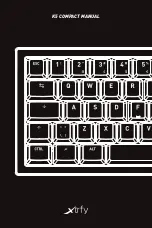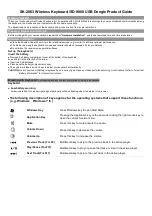
10-120
KDFX Reference
KDFX Algorithm Specifications
Mic Pos
The angle of the virtual microphones in degrees from the “front” of the rotating speaker.
This parameter is not well suited to modulation because adjustments to it will result in
large sample skips (audible as clicks when signal is passing through the effect). There are
four of these parameters to include 2 pairs (A and B) for high and low frequency drivers.
Mic Lvl
The level of the virtual microphone signal being sent to the output. There are four of these
parameters to include 2 pairs (A and B) for high and low frequency drivers.
Mic Pan
Left-right panning of the virtual microphone signals. A settings of -100% is panned fully
left, and 100% is panned fully right. There are four of these parameters to include 2 pairs
(A and B) for high and low frequency drivers.
LoResonate
A simulation of cabinet resonant modes express as a percentage. For realism, you should
use very low settings. This is for the low frequency signal path.
Lo Res Dly
The number of samples of delay in the resonator circuit in addition to the rotation
excursion delay. This is for the low frequency signal path.
LoResXcurs
The number of samples of delay to sweep through the resonator at the rotation rate of the
rotating speaker. This is for the low frequency signal path.
HiResonate
A simulation of cabinet resonant modes express as a percentage. For realism, you should
use very low settings. This is for the high frequency signal path.
Hi Res Dly
The number of samples of delay in the resonator circuit in addition to the rotation
excursion delay. This is for the high frequency signal path.
HiResXcurs
The number of samples of delay to sweep through the resonator at the rotation rate of the
rotating speaker. This is for the high frequency signal path.
ResH/LPhs
This parameter sets the relative phases of the high and low resonators. The angle value in
degrees is somewhat arbitrary and you can expect the effect of this parameter to be rather
subtle.
Summary of Contents for K2661
Page 18: ...2 4 LFOs LFO Shapes...
Page 34: ...3 16 DSP Algorithms...
Page 54: ...5 4 MIDI Note Numbers Note Numbers for Percussion Keymaps...
Page 72: ...7 10 System Exclusive Protocol K2661 System Exclusive Implementation...
Page 82: ...9 4 Upgrading Sample Memory Choosing and Installing a SIMM for K2661 Sample Memory...
Page 334: ...10 252 KDFX Reference KDFX Algorithm Specifications...
Page 340: ...11 6 Glossary...
Page 382: ...12 42 Triple Modular Processing Alphanumeric Buttonpad Entries for DSP Functions...
Page 392: ...B 6 SysEx Control of KDFX MSB and LSB...
Page 442: ...D 20 Contemporary ROM Block Objects Controller Assignments Contemporary ROM Block...
Page 490: ...H 12 General MIDI Standard Mode Controller Assignments...
Page 492: ...I 2 Live Mode Objects Live Mode Programs...
Page 498: ...K2661 Musician s Reference Index...
Page 500: ......















































